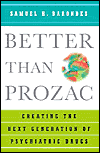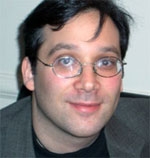Most of the psychiatric drugs we use today are refinements of drugs whose value for mental disorders was discovered by accident decades ago. Now we can look forward to a more rational way to design psychiatric drugs. It will be guided by the identification of the gene variants that predispose certain people to particular mental disorders such as schizophrenia or severe depression.


Introduction
Psychiatrist Samuel Barondes, M.D. is interested in the ways that chemicals influence mental processes. "Despite decades of tinkering," he notes, "the drugs we presently use still have serious limitations. First, they don't always work. Second, they still have many undesirable side effects. Instead of continuing to invest in more minor improvements, pharmaceutical companies are becoming interested in a new approach to psychiatric drug development." In this discusion he traces the accidental discovery of LSD by Albert Hoffman in 1943 as a contribution to a milieu that favored the discovery of many psychiatric medications.
For example, he notes that "in the course of just a few years there were these two discoveries of extremely valuable psychiatric drugs that radically changed the practice of psychiatry. Before the discovery of chlorpromazine and imipramine disorders like schizophrenia and major depression were usually dealt with by talking, exhortation, and hospitalization—and with limited success. With these new drugs many patients had remarkable improvements."
There are new approaches that take advantage of the fact that there are genetic vulnerabilities to mental disorders. "The hot new technologies that psychiatric scientists are now using," he says, "include not only genetics but also brain imaging...It will be possible to correlate knowledge about genetic variation with knowledge about how specific brains operate in specific circumstances, as looked at with various kinds of functional magnetic resonance imaging. Right now our ideas about mental disorders are mainly based on interviews, questionnaires, and observations of behavior. Being able to look at what's going on inside the human brain, once considered to be an inscrutable black box, is turning out to be quite informative."
—JB
SAMUEL H. BARONDES is the Jeanne and Sanford Robertson Professor and director of the Center for Neurobiology and Psychiatry at the University of California, San Francisco. He is past president of the McKnight Endowment Fund for Neuroscience and recently served as chair of the Board of Scientific Counselors of the National Institute of Mental Health.
Barondes is interested in psychiatric genetics and psychopharmacology. He is the author of Molecules and Mental Illness; Mood Genes: Hunting for the Origins of Mania and Depression; and Better Than Prozac: Creating the Next Generation of Psychiatric Drugs.
Samuel Barondes' Edge Bio Page

The idea that animals can be used to study mental illness strikes many people as strange, because human behavior seems unique. After all, only humans use language for introspection and long-range planning, and it is just these functions that are disturbed in many psychiatric disorders. Nevertheless, we have enough in common with other animals to make them very useful for studies that can’t be done with patients.
Of the animals used for this purpose, apes and monkeys have been favorites because they are our closest relatives. Dogs, too, have obvious human qualities. They may even display patterns of maladaptive behavior that resemble those in DSM-IV. For example, Karen Overall, a professor in the School of Veterinary Medicine at the University of Pennsylvania, has been studying a dog version of obsessive-compulsive disorder (OCD), which is fairly common in certain breeds. Like people with OCD who each have their particular patterns of symptoms, individual dogs with canine OCD also have distinctive main symptoms such as tail-chasing or compulsive licking of their paws. Like humans with OCD, the dogs tend to perform their rituals in private. And, like human OCD, the canine version responds to drugs such as clomipramine and Prozac. Because of these many similarities, Overall’s dogs may provide information about the human disorder—an aim that has already been achieved for another canine behavioral disorder that I will turn to shortly.
But despite their value for certain types of studies, primates and dogs are not ideal experimental animals. Their main shortcoming is that they are costly to raise and maintain, which makes them impractical for the many experiments that require large numbers of subjects. For this reason scientists have been turning to a much less expensive alternative, the laboratory mouse. Although it is more difficult to empathize with these tiny rodents than with a chimpanzee or a golden retriever, we now know that all these mammals share much of our complex brain machinery. What makes mice especially attractive is that their genes are relatively easy to manipulate by traditional breeding methods and by the new techniques of genetic engineering. Both experimental approaches have been successfully employed to make special strains of mice that are being used to study mental disorders and to develop new psychiatric drugs.








